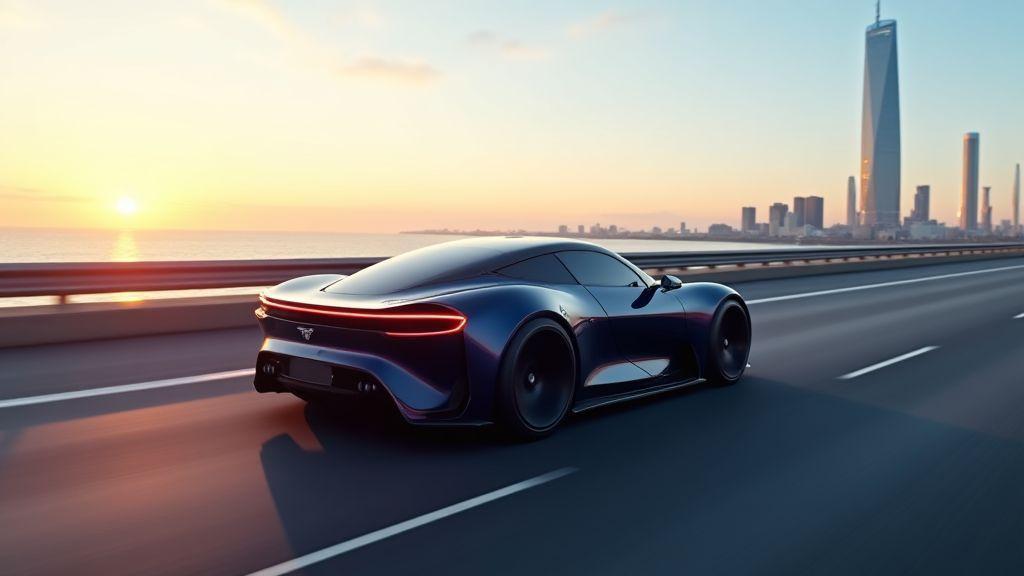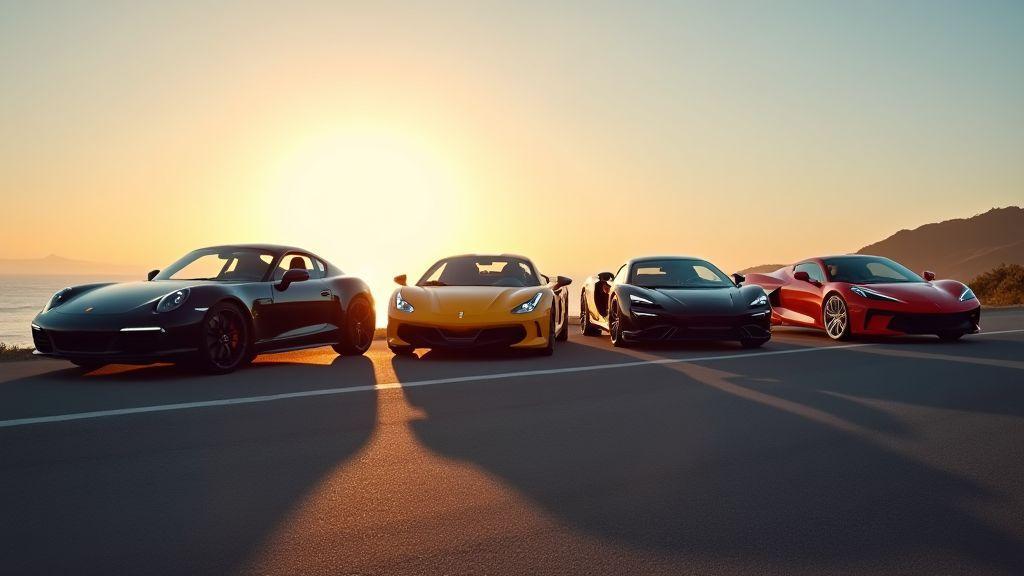The Evolution of Sports Cars: From the Sixties to Today
The Evolution of Sports Cars: From the 60s to Today opens your view on how style, power, and technology reshaped sports cars. You will trace iconic design from the Jaguar E-Type and the Ford Mustang to Porsche roadsters, see how American V8 muscle and creative design set trends, and learn how aerodynamics, lighter weight, turbocharging and electronics boosted speed and safety. You will explore key tech like fuel injection, ABS, traction control, and active aero, and how the rise of electric sports cars reshapes the market and the future.
Key takeaway
- Classic design cues shape modern sports cars.
- Engines became more powerful and efficient.
- Electronics and driver aids improved safety and performance.
- Lighter materials improved performance and protection.
- Electric and hybrid sports car options are widely available today.

1960s sports cars and classic sportscar design that shaped style and the evolution of sports cars
You can trace The Evolution of Sports Cars: From the 60s to Today back to a few bold design moves in the 1960s. That decade pushed cars from pure utility into expression. Long hoods, low roofs, and curving fenders made cars look fast even when parked. You feel that drama when you walk past an E-Type or Mustang at a car meet — like seeing a rock star in a leather jacket.
Design was driven by racing and buyers who wanted flair. Lightweight bodies, aluminum panels, and tight cockpits came from the track. Manufacturers borrowed what worked on the circuit and put it on the street. That mix of function and show gave sports cars a language you still read in modern models.
Culture fed the look too. Younger buyers wanted excitement and identity. Movies, magazines, and hot-rodding shops spread the image fast and pushed companies to take risks with shape and color. The result: designs that still pull at your heartstrings on a Sunday drive.
Iconic sports car models: Jaguar E-Type, Porsche 911, Ford Mustang
Three cars summed up the 60s in different ways and each left a clear mark. The Jaguar E-Type brought European elegance and speed in a sinuous body. The Porsche 911 offered a new take on balance and handling with its rear-engine layout and timeless silhouette. The Ford Mustang delivered excitement to the masses, proving performance could be affordable and stylish. You can read more about the Porsche 911 design and historical evolution.
| Model | Launch Year | Signature Feature | Why it mattered |
|---|---|---|---|
| Jaguar E-Type | 1961 | Long bonnet, sleek curves | Luxury sports car that redefined beauty and performance |
| Porsche 911 | 1964 | Rear-engine balance, compact shape | A shape and drive feel that evolved for decades |
| Ford Mustang | 1964 | Affordable V8 options, fastback | Sparked the pony car class and youth culture appeal |
These cars taught you how to read a brand: the E-Type whispered exclusivity, the 911 promised precision, and the Mustang shouted personality. You can spot echoes of each in today’s designs — little hood lines, round headlights, or a growling V8 note.
Muscle cars: American V8 power and the 1960s sports car boom
Muscle cars rode a wave of cheap gas, big engines, and teenagers with license plates. Builders squeezed big V8s into light frames and created raw, loud performance felt on drag strips and Main Street alike. You felt power in a stomp of the accelerator and a thunder of exhaust.
The boom cooled by the 1970s due to insurance, emissions, and fuel shocks, but the spirit stayed in pop culture. Today’s modern muscle borrows old sound and shape while wrapping it in safety tech and better brakes, delivering the thrill with fewer compromises.
How classic sportscar design influenced later models
Classic cues — long hoods, short rear decks, low roofs, wide stances, and bold lights — became shorthand for sports car. Automakers reuse those lines to tap emotion while adding modern aero, safer structures, and digital interfaces. You get familiar shapes with improved function and comfort.
- Long hood, short deck — signals performance
- Low roof and wide stance — suggests grip and speed
- Simple, bold lights — instant recognition
- Minimal cockpits — driver focus, modernized with tech
Sports car technology advancements and aerodynamics in sports cars for speed and safety
You feel the change when you sit in a modern sports car: tighter cabin, crisper steering, and a car that cuts through air like a knife. Over decades, engineers moved from brute horsepower to smarter shapes and systems — central to The Evolution of Sports Cars: From the 60s to Today, and explaining why modern cars go faster while keeping you safer. For more on the basic principles of vehicle aerodynamics and drag.
Aerodynamics evolved from simple spoilers to full aero packages that push the car into the road. More grip at high speed and better stability in corners mean you can trust the car when you push it. Electronics and materials work hand in hand with aero: lightweight panels and active systems change aero in real time, giving quicker responses, lower lap times, and fewer surprises.
- Fuel-efficient powertrains, active aero, carbon fiber structures, and advanced driver aids are now core features.
How aerodynamics improved top speed and cornering
Top speed gains come when drag drops. Engineers trim frontal area, smooth underbodies, and tune wing profiles so more of the engine’s power turns into forward motion. Cornering improved because downforce adds grip; wings, diffusers, and splitters push the car into the pavement so you can carry more speed through a turn and brake later.
| Aero element | What it does | Real effect for you |
|---|---|---|
| Front splitter | Redirects air under/around car | More front grip, reduces understeer |
| Rear wing/diffuser | Generates downforce and smooths exit airflow | Better rear stability at speed |
| Active flaps/vents | Change aero balance on the fly | Optimizes for speed or cornering |
Performance trends: lighter weight, turbocharging, and electronics
Lighter cars accelerate and turn easier. Manufacturers cut weight with aluminum or carbon fiber, so brakes and tires work more effectively. Turbocharging added power without huge engines; small turbo engines give big torque and better mileage. Electronics tie it together: traction control, engine maps, and active differentials let you extract power safely. The result: cars that are fast, versatile, and forgiving at the limit.
Key tech milestones: fuel injection, ABS, traction control, active aero
Fuel injection sharpened throttle response and efficiency. ABS prevents wheel lock in panic stops. Learn more about the anti-lock braking system and safety benefits. Traction control curbs wheelspin for repeatable launches. Active aero adjusts downforce for speed or cornering. Together, these milestones changed how you drive and how safe you are at the edge.

Electric sports cars development and the future of sports cars in the market
You can see the shift from loud V8s to silent electric packs as a clear chapter in The Evolution of Sports Cars: From the 60s to Today. Electric power has rewritten the rulebook on torque, launch speed, and packaging. Where an engine once sat, you now get batteries and motors that lower the center of gravity and sharpen handling. That changes how a sports car feels on a back road and how you choose one. If you’re new to EVs, review the electric vehicle basics and drivetrains explained.
Automakers and startups race to match or beat petrol sports cars on performance and appeal. Falling battery costs and better power electronics mean more models, wider price ranges, and faster development. See data on global electric vehicle market trends and projections. Legacy brands and new names now compete with track-ready EVs and tech-rich coupes for everyday use.
What you buy depends on charging access, service options, and how you drive. If you need to reach our team for comparisons or clarification, use the site contact page. Urban owners care about daily range and fast charging; track-day fans want heat-resistant cells and instant power delivery. That split will shape dealer lots: raw, driver-focused machines and polished, practical offerings will both be available.
Rise of electric sports cars since the 2010s: Tesla Roadster, Porsche Taycan, and others
Early 2010s efforts proved electric sports cars could thrill. The original Tesla Roadster showed EVs could sprint and excite. Porsche’s Taycan translated brand feel to an electric platform while keeping identity. Startups like Rimac and Lucid pushed battery layout and software control, raising the bar for handling and electronics. In less than two decades, EVs went from niche concepts to showroom contenders.
| Model | Year introduced | 0–60 mph (approx) | Range (EPA or claimed) | Notable point |
|---|---|---|---|---|
| Tesla Roadster (original) | 2008 | 3.7 sec | ~244 miles (original pack) | Proved EV sports viability |
| Porsche Taycan | 2019 | 2.4–5.1 sec | 200–300 miles (est.) | Porsche driving feel, fast charging |
| Rimac Nevera | 2021 | ~1.85 sec | ~340 miles (WLTP) | Hypercar-level performance |
| Tesla Roadster (upcoming) | TBA | ~1.9 sec (claimed) | ~620 miles (claimed) | Extreme range and acceleration claims |
Regulations and buyer demand that shape the future of sports cars
Regulations push firms to cut emissions and improve safety. Tighter CO2 standards and low-emission zones accelerate electrification for sports cars. Makers that adapt quickly will stay relevant.
Buyers want performance, but also value, resale, and lower running costs. Top priorities now:
- Quick charging and usable range
- Real-world performance and handling
- Maintenance costs and warranty terms
- Brand trust and resale value
- In-car tech and software updates
Cars that balance speed with practicality will win: weekend track toys for enthusiasts and pulse-raising daily drivers for others.
What current electric and tech trends mean for the future of sports cars
Battery energy density, thermal management, and software-defined systems will shape the next decade. Expect improvements in lap times, charging speed, and adaptability through updates. Modular platforms will let brands swap battery packs or motor layouts, and software will tune handling for street or track with the tap of a screen. As software plays a larger role, review the site’s privacy practices and terms of use to understand how data and updates are handled.
Conclusion
You’ve traced a clear line from 1960s design bravado to today’s tech-driven performance. Classic cues — long hoods, low roofs, simple lamps — still whisper identity while modern cars answer with lighter materials, refined aerodynamics, and smarter electronics. Performance stopped being just brute power; it became precision.
Turbocharging, fuel injection, ABS, traction control, and active aero taught cars to be faster and safer. Electric propulsion then changed packaging, torque delivery, and expectations at the lights: instant torque, quieter thunder. The Evolution of Sports Cars: From the 60s to Today is a story of heritage meeting software, emotion meeting efficiency, and craft blending with code.
For buyers, the choice is real: chase old-school V8 character or embrace instant-response EVs that lower the center of gravity and sharpen handling. Regulations and shifting tastes mean manufacturers balance range, charging, safety, and resale. The market will give both weekend thrills and everyday practicality.
Keep your eyes on both the silhouette and the spec sheet. Explore more on the Meridian Pioneer homepage.

